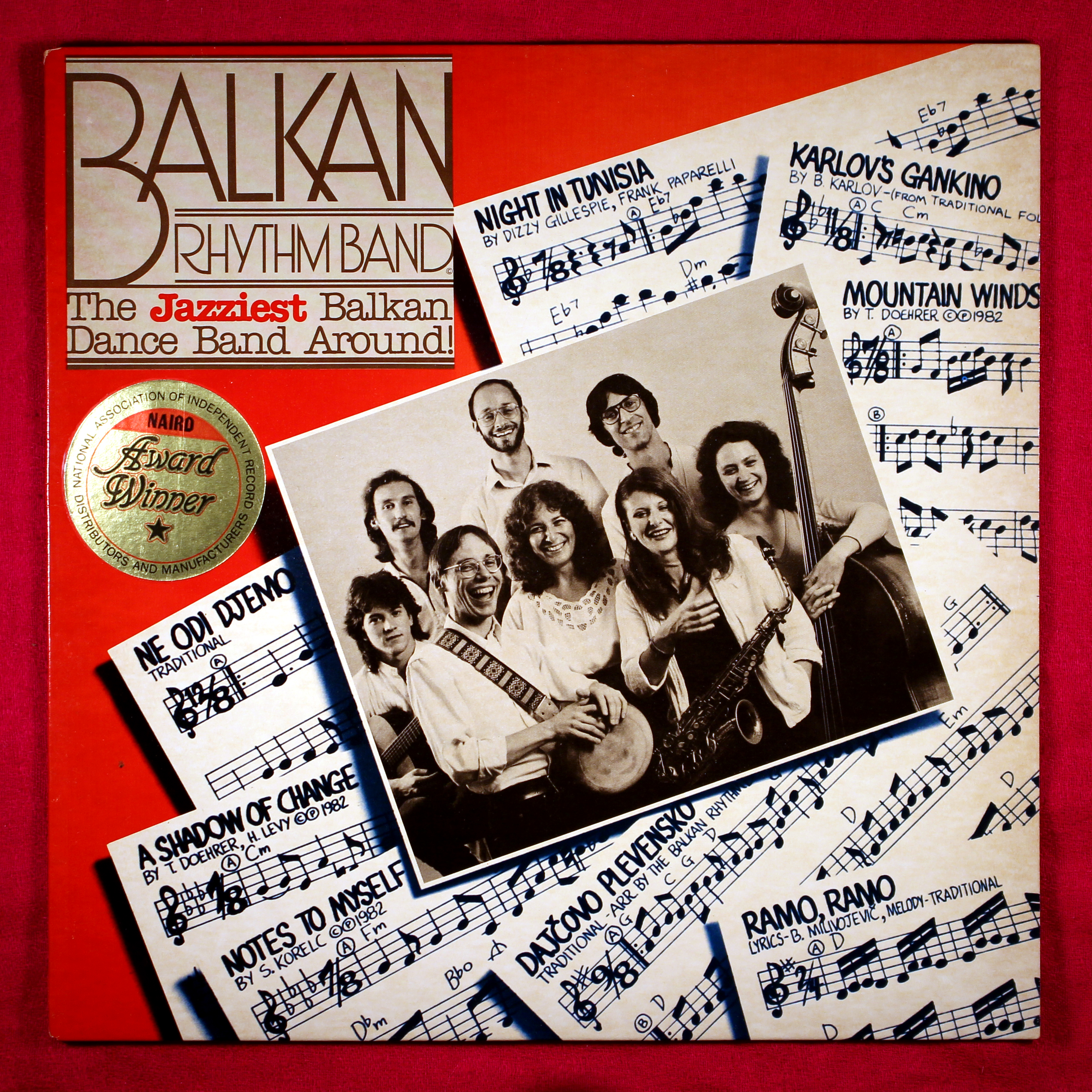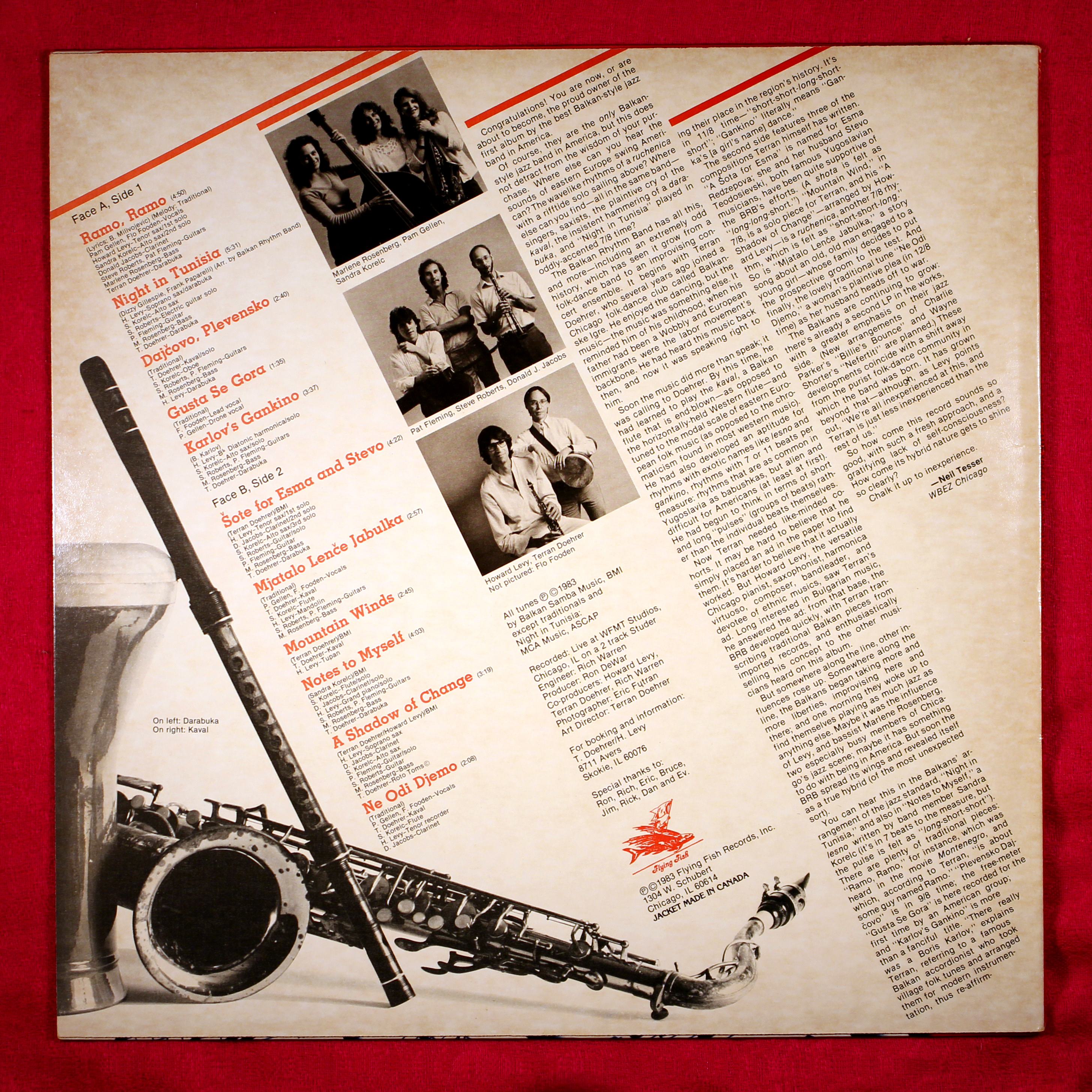MODAL MUSIC
World Music Bands
Liner notes for the Balkan Rhythm Band’s 1983 Flying Fish Records LP FF314
The Jazziest Balkan Rhythm Band Around
Written by jazz critic and jazz DJ, Neil Tesser

“Congratulations! You are now, or are about to become, the proud owner of the first album by the best Balkan-style jazz band in America.
“Of course, they are the only Balkan-style jazz band in America, but this does not detract from the wisdom of your purchase. Where else can you hear the sounds of eastern Europe swing American? The wavelike rhythms of a ruchenica with a rifftide solo sailing above? Where else can you find — all in the same band — singers, saxists, the plaintive cry of the kaval, the insistent hammering of a darabuka, and ‘Night in Tunisia’ played in oddly-accented 7/8 time?
The Balkan Rhythm Band has all this, and more — including an extremely odd history, which has seen it grow from a folk-dance band to an improvising concert ensemble. It begins with Terran Doehrer, who several years ago joined a Chicago folk-dance club called Balkanske Igre. He enjoyed the dancing, but the music — the music was something else. It reminded him of his childhood, when his father had been a Wobbly and European immigrants were the labor movement’s backbone. He had heard this music back then, and now it was speaking right to him.
Soon the music did more than speak; it was calling to Doehrer. By this time, he had learned to play the kaval, a Balkan flute that is end-blown — as opposed to the horizontally-held Western flute — and tuned to the modal scale of eastern European folk music (as opposed to the chromaticism found in most western music). He had also developed an aptitude for rhythms with exotic names like lesno and gankino, rhythms with 7 or 11 beats per measure: rhythms that are as common in Yugoslavia as babushkas, but alien and difficult for Americans (at least at first). He had begun to think in terms of short and long “pulses” (groups of beats) rather than the individual beats themselves.
Now Terran needed like-minded cohorts. It may be hard to believe that he simply placed an ad in the paper to find them. It’s harder to believe that it actually worked. But Howard Levy, the versatile Chicago pianist, saxophonist, harmonica virtuoso, composer, bandleader, and devotee of ethnic musics, saw Terran’s ad. Long interested in Bulgarian music, he answered the ad: from that base, the BRB developed quickly, with Terran transcribing traditional Balkan pieces from imported records, and enthusiastically selling his concept to the other musicians heard on this album.

But somewhere along the line, other influences rose up. Somewhere along the line, the Balkans began taking more and more liberties, imprvising here and there; and one morning they woke up to find themselves playing as much jazz as anything else. Maybe it was the influence of Levy, and bassist Marlene Rosenberg, two especially busy members of Chicago’s jazz scene; maybe it has something to do with being in America. But soon the BRB spread its wings and revealed itself as a true hybrid (of the most unexpected sort).
You can hear this in the Balkans’ arrangement of the jazz standard, “Night in Tunisia,” and also in “Notes To Myself,” a lesno written by band member Sandra Korelc (it’s written in 7 beats to the measure, but the pulse is felt as “long-short-short”). There are plenty of traditional pieces: “Ramo, Ramo,” for instance, which was heard in the movie Montenegro, and which, according to Terran, “is about some guy named Ramo.” “Plevensko Dajčovo” is in 9/8 time; the free-meter “Gusta Se Gora” is here recorded for the first time by an American group; and “Karlov’s Gankino” is more than a fanciful title. “There really was a Boris Karlov,” explains Terran, referring to a famous Balkan accordionist who took village folk tunes and arranged them for modern instrumentation, thus re-affirming their place in the region’s history. It’s in 11/8 time — “short-short-long-short-short”; “Gankino” literally means Ganka’s [a girl’s name] dance.”
The second side features three of the compositions Terran himself has written. ”A Šote for Esma” is named for Esma Redzepova; she and her husband Stevo Teodosievski, both famous Yugoslavian musicians, have been quite supportive of the BRB’s efforts. (A shota is felt as “long-long-short.”) “Mountain Winds,” in 7/8, is a solo piece for Terran, and his “A Shadow of Change” — arranged by Howard Levy — is a ruchenica, another 7/8 rhythm, which is felt as “short-short-long.” So is “Mjatalo Lenče Jabulka,” a story song about an old, old man engaged to a young girl — whose family decides to put the prospective groom to the test. And finally, the lovely traditional tune “Ne Odi Djemo,” a woman’s plaintive plea (in 12/8 time) as her husband heads off to war.
The Balkans are continuing to grow: there’s alrady a second LP in the works, with a greater emphasis on their jazz side. (New arrangements of Charlie Parker’s Billie’s Bounce” and Wayne Shorter’s “Nefertiti” are planned.) These developments coincide with a shift away from the purist folk-dance community in which the band was born. It has grown beyond that — although, as Levy points out, “We’re all inexperienced at this, and Terran is just less inexperienced than the rest of us.”
So how come this record sounds so good, with such a fresh approach, and a gratifying lack of self-consciousness? How come its hybrid nature gets to shine so clearly?
Chalk it up to inexperience.
—Neil Tesser
Jazz DJ, WBEZ Radio Chicago
This video was made using a track, “Shote For Esma And Stevo,” from “The Jazziest Balkan Dance Band Around” LP, in all its seven-piece band glory, as the video’s sound track! This tune was written by Terran Doehrer, the band’s founder and leader.
Thank you!
We appreciate your support!